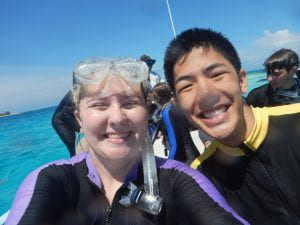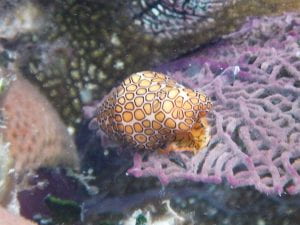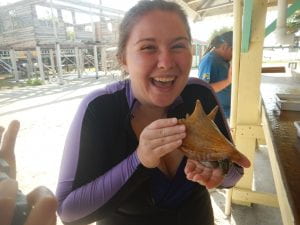Hi!
Today was a pretty awesome, mollusc-filled day. In the morning we used quadrats to measure live coral cover on a reef patch within the MPA (Marine Protected Area) and then on a reef patch outside of the MPA. Then in the afternoon we collecting specimens for our own touch tank!

I didn’t see any molluscs within the MPA but I did see a Brain Coral with Black Band Disease. Black Band is caused by a bacterial pathogen; it’s progressive and incredibly distinctive because there’s the live tissue, then a dark band of bacterial mat, then a white band of newly dead tissue, then old dead coral that’s been colonized by algae. I’m a little sad that I saw it, especially in the protected zone, but also excited that I was able to spot it in the wild after learning about it in classes. It was also cool to be able to visualize microbes in action. My topic lecture was Microbes, and one thing that I personally find a little frustrating is that microbes are so small you can’t always see the impact they have so clearly.

Outside the MPA we saw a whole bunch of Flamingo Tongue Snails (Cyphoma gibbosum) and I learned that if you scream underwater because you’re excited people will think you’re in trouble. The Flamingo Tongues are super brightly colored and generally easy to find because they’re usually on Gorgonians, so I was turning over sea fans left and right looking for them. Also, not a mollusc, but I learned what Fire Coral is at this patch reef…that was…fun…they don’t like to be touched.

In the afternoon we got a ton of molluscs for our touch tank! We got four Queen Conchs (Stombus gigas), two of which were very friendly and came out of their shells to slime around in my hand. We also got three Milk Conchs (Strombus costatus), which had broader flatter shells with shorter spires, had a bright red interior, and were not nearly as friendly. We had two more critters in the Gastropod department, but I’m not sure what they were yet. One had a shell that looks like it could be some kind of Murex snail, and the other had a rounded spiral shell with no spire and a circular operculum. Lastly, and most exciting, Kaela caught an octopus and used the guides to identify it as an Atlantic Pygmy Octopus (Octopus joubini). It was very small, had large eyes, and could change colors, but the identifying feature was how long and thin the arms were.


In only a few days we’ve found so many molluscs, but the search isn’t over. We still have to find a sea slug (I keep picking up algae thinking it’s a Lettuce Slug and being disappointed), a living bivalve (I keep finding sad empty shells), and a Caribbean Reef Squid (we already have a Cephalopod, I just want to see this one).
-Kelsey
